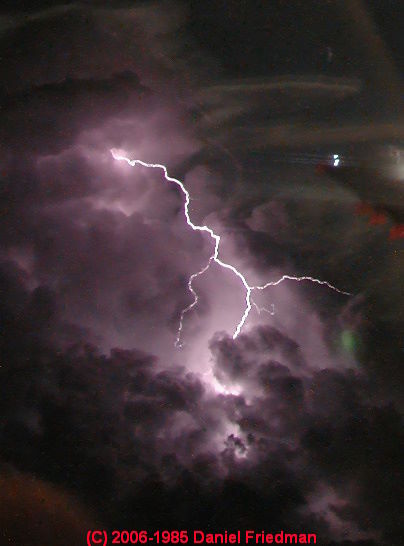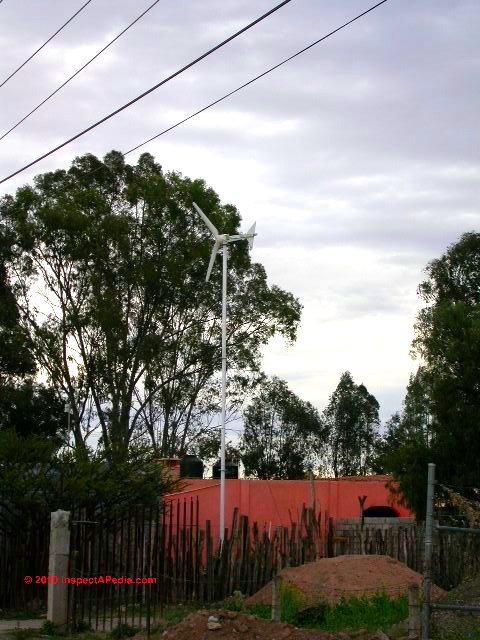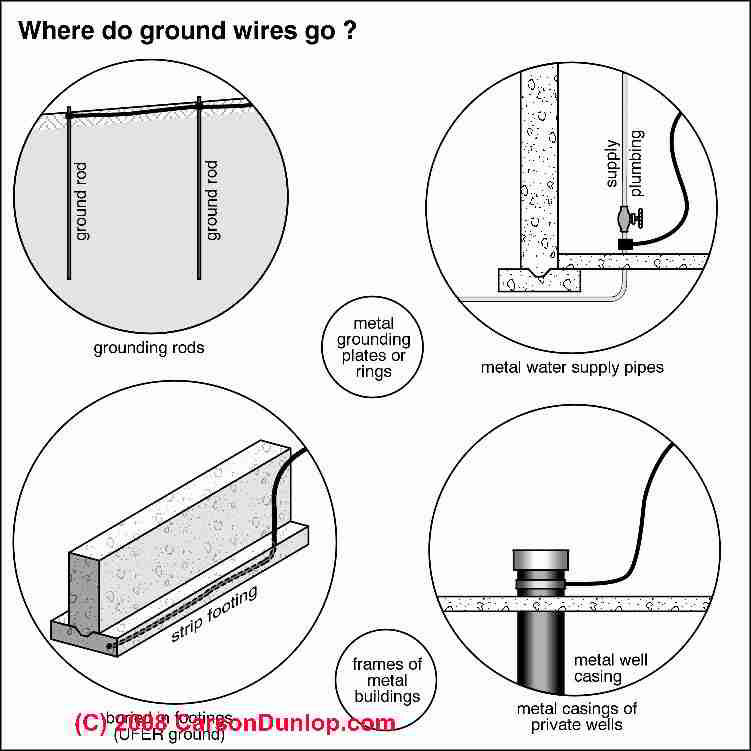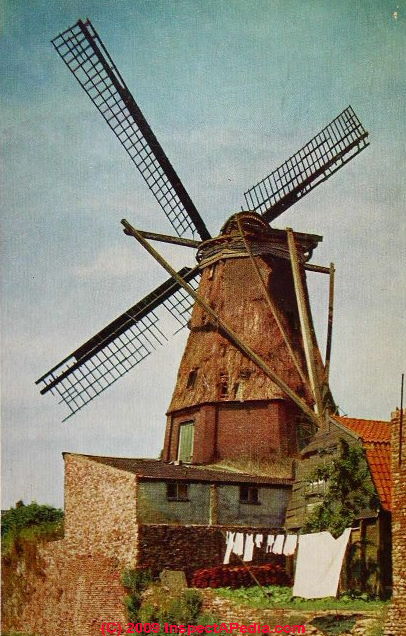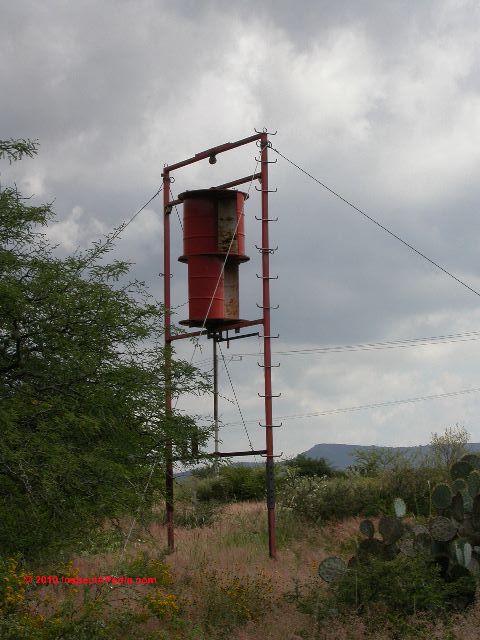 Wind Generator Lightning Protection
Wind Generator Lightning Protection
- POST a QUESTION or COMMENT about lightning strike protection for wind generators and wind turbines
Wind turbine lightning strike protection:
This article describes common steps to avoid lightning strike damage to controls, batteries, and other wind turbine electrical generator system components.
We provide information about lightning strikes, lightning hazards, related equipment, sources of lightning protection system installers, and lightning strike risk assessment.
InspectAPedia tolerates no conflicts of interest. We have no relationship with advertisers, products, or services discussed at this website.
- Daniel Friedman, Publisher/Editor/Author - See WHO ARE WE?
Lightning Protection Details for Wind Turbine Controls & Circuits
Our page top photo shows a wind generator installed by Aero-Solar in San Miguel de Allende, Mexico where by 2010 many local solar & wind power companies offered wind turbine and solar power generation installation services.
In January 2010 the New York Times reported that the U.S. is close to producing 2 percent of its electricity from wind turbines, and that wind power production grew in the United States during 2008 and 2009 by a total of 57%. [2008 (18%) and 2009 (39%)]., adding 9,900 megawatts of electrical energy in 2009 alone (according to the American Wind Energy Association).
Use of wind power and its increased growth may help reduce emissions of gases that cause the increasingly rapid worldwide problem of global warming.
In January and February 2010 the New York Times reported that most of the wind turbines and wind energy being installed in the U.S. as well as most of the solar panels being used in the U.S. are being produced in China, and that G.E. (General Electric) makes nearly half the wind turbines used in the United States. U.S.
Most of this wind power growth was in large wind turbines delivered to wind farms primarily in Texas, Iowa, California, Washington, and Minnesota, and aided by President Obama's economic stimulus package.
Put in context, this was about the same amount of energy production increase in the U.S. as was provided from growth in production of natural gas, and the combination of those two energy sources accounted for 80% of all new electricity generation capacity in the country.
We report on the rate of growth of wind-generated electrical power
Below we discuss how lightning protection is provided for electrical power generating wind turbines. Text below is reprinted/adapted/excerpted with permission from Solar Age Magazine - editor Steven Bliss.
Question: We have installed a 1935-vintage Jacobs wind generator (1500 watts; 35 volts DC) on an island in Wisconsin. Since the 55-foot tower is on a hill in the middle of a lake, it gets hit with lightning all the time. We have a standard electrical panel box but an electronic charging control.
The wind generator tower has a lightning arrestor and a ground rod. Each time lightning hits, the lightning strike destroys an integrated circuit and a couple of transistors.
- How can we prevent even small charges from the lightning from going into the electrical panel box?
- What effect does lightning have on storage batteries when it passes through them?
- Richard Armhein, North Oaks, MN
Answer: You should probably have surge suppressors on every wire entering your electrical panel box.
The surge arrestors should be grounded to the existing ground rod. Never use separate ground rods for different parts of the same installation.
The ground rod or stake should make better contact with moisture in the earth than do the wind turbine generator tower footings.
But in some locations, such as on hilltops where wind generators perform best, the risk of lightning strike is greater. Since your wind generator system is on a hill, you might want to check this (on a sunny day with no risk of a lightning strike while you are working).
Installing a lightning rod at the top of your wind generator tower isn't likely to protect your electronic equipment further and may not be cost-effective because the lightning rod may interfere with the wind's flow around the wind generator's turbine blades.
Lightning strike current passing through your storage batteries could be expected to destroy them by means of a powerful (and dangerous) explosion. But the lightning may also be inducing transient surges in the batteries. It is doubtful that they cause any harm.
Watch out: Engineers we spoke with stressed that generic answers are not universally right. Since lightning has a deadly potential, show your installation or an accurate diagram of it to a qualified electrical engineer who specializes in lightning arrestor system design.
See LIGHTNING PROTECTION SYSTEMS for details; also
at LIGHTNING PROTECTION SYSTEMS DEFINED the UL illustration caption recommends a secondary surge arrestor on electrical service conductors or at the electrical service panel
While some details about electrical ground rods are shown just below, readers should also
Lightning Protection System Certification for Wind Turbines

Lightning protection systems are examined and certified by Underwriters Laboratories, Inc.
Be sure your installer is listed by UL and that a Master Label application is submitted to UL for your installation. There are other listing and certifying agencies as well, including the Lightning Protection Institute (LPI) and the National Fire Protection Association (NFPA).
Verify that your Wind Generator Lightning Protection System Installer is UL-Listed
To verify that an installer is Listed or to obtain further information call the Follow-Up Services Department at UL, 1285 Walt Whitman Road, Melville, NY 11747 516/271-6200. UL has other offices in Northbrook, IL, Santa Clara, CA, and Research Triangle Park, NC.
Where do Electrical Ground Wires Go?
As Carson Dunlop Associates' sketch shows here, from the main electrical panel a grounding conductor connects to:
- a pair of grounding electrodes,
- a metal water pipe entering the building from outside,
- a strip footing which contains metal in contact with the earth
- to the metal casing of a private well
Readers should also
see DEFINITIONS of Electrical Ground, Grounding Electrode, Grounding Conductor, Grounded Conductor, Ground Wire, Neutral Wire, Ground Rod, for definitions of these confusing electrical terms.
More details about electrical grounding can be read
at ELECTRIC SERVICE GROUNDING SYSTEM INSPECTION.
Here we include solar energy, solar heating, solar hot water, and related building energy efficiency improvement articles reprinted/adapted/excerpted with permission from Solar Age Magazine - editor Steven Bliss.
Examples of Wind Generators & Windmills for Power Generation or Water Pumping
Please see WIND ENERGY SYSTEMS for our full article on this topic. Excerpts follow.
Windmills and Wind Powered Water Pumps
Even antique or small home-made wind energy systems should have lightning protection.
Our photos show two systems that lack that safety feature: the old windmill on the city rampart at Montfoort, Holland (above), and (below) a home-built vertical-axis barrel rotor wind energy system in El Charco, above San Miguel de Allende, Mexico.
The vertical axis windmill has the advantage that it does not have to be oriented towards wind-direction.
But the slow axis speed and the 20% efficiency of the split barrel design means that like the Dutch windmill above, these two wind energy systems are most suitable for water pumping applications.
Original article
- LIGHTNING PROTECTION DETAILS FOR WIND TURBINES [PDF] - use your browser's back button to return to this page
The question-and-answer article about wind turbines and lightning damage protection appears in expanded text above and quotes-from, updates, and comments an original article from Solar Age Magazine and written by Steven Bliss.
...
Continue reading at WIND ENERGY SYSTEMS or select a topic from the closely-related articles below, or see the complete ARTICLE INDEX.
Or see these
Recommended Articles
- ELECTRIC SERVICE GROUNDING SYSTEM INSPECTION
- ENERGY SAVINGS in BUILDINGS
- LIGHTNING PROTECTION SYSTEMS
- REMOTE ELECTRIC POWER, PHOTOVOLTAIC
- SOLAR ENERGY SYSTEMS
- WIND ENERGY SYSTEMS
- WIND TURBINES & LIGHTNING
Suggested citation for this web page
WIND TURBINES & LIGHTNING found at InspectApedia.com - online encyclopedia of building & environmental inspection, testing, diagnosis, repair, & problem prevention advice.
Or see this
INDEX to RELATED ARTICLES: ARTICLE INDEX to BUILDING ENERGY SAVINGS
Or use the SEARCH BOX found below to Ask a Question or Search InspectApedia
Ask a Question or Search InspectApedia
Questions & answers or comments about lightning strike protection for wind generators and wind turbines
Try the search box just below, or if you prefer, post a question or comment in the Comments box below and we will respond promptly.
Search the InspectApedia website
Note: appearance of your Comment below may be delayed: if your comment contains an image, photograph, web link, or text that looks to the software as if it might be a web link, your posting will appear after it has been approved by a moderator. Apologies for the delay.
Only one image can be added per comment but you can post as many comments, and therefore images, as you like.
You will not receive a notification when a response to your question has been posted.
Please bookmark this page to make it easy for you to check back for our response.
IF above you see "Comment Form is loading comments..." then COMMENT BOX - countable.ca / bawkbox.com IS NOT WORKING.
In any case you are welcome to send an email directly to us at InspectApedia.com at editor@inspectApedia.com
We'll reply to you directly. Please help us help you by noting, in your email, the URL of the InspectApedia page where you wanted to comment.
Citations & References
In addition to any citations in the article above, a full list is available on request.
- Solar Age Magazine was the official publication of the American Solar Energy Society. The contemporary solar energy magazine associated with the Society is Solar Today. "Established in 1954, the nonprofit American Solar Energy Society (ASES) is the nation's leading association of solar professionals & advocates. Our mission is to inspire an era of energy innovation and speed the transition to a sustainable energy economy. We advance education, research and policy. Leading for more than 50 years. ASES leads national efforts to increase the use of solar energy, energy efficiency and other sustainable technologies in the U.S. We publish the award-winning SOLAR TODAY magazine, organize and present the ASES National Solar Conference and lead the ASES National Solar Tour – the largest grassroots solar event in the world."
- Steve Bliss's Building Advisor at buildingadvisor.com helps homeowners & contractors plan & complete successful building & remodeling projects: buying land, site work, building design, cost estimating, materials & components, & project management through complete construction. Email: info@buildingadvisor.com
Steven Bliss served as editorial director and co-publisher of The Journal of Light Construction for 16 years and previously as building technology editor for Progressive Builder and Solar Age magazines. He worked in the building trades as a carpenter and design/build contractor for more than ten years and holds a masters degree from the Harvard Graduate School of Education. Excerpts from his recent book, Best Practices Guide to Residential Construction, Wiley (November 18, 2005) ISBN-10: 0471648361, ISBN-13: 978-0471648369, appear throughout this website, with permission and courtesy of Wiley & Sons. Best Practices Guide is available from the publisher, J. Wiley & Sons, and also at Amazon.com - Portions of this information are based on UL publication 200-81 11/87 and other local service company information about lightning protection systems and lightning strike hazards.
- Special thanks to www.alrci.com/ Associated Lightning Rod Company, Cooper Road Box 329A, Millerton NY who has been contributing technical content in presentations
to NY ASHI home inspectors since 1996. Some of that information [on lightning system material and installation details] was edited for clarity.
ALRCi can be reached at 518-789-4603, 845-373-8309, 860-364-1498 and will inspect your lightning protection system at no charge. [We have no financial nor any other business relationship with any company or product discussed at this website--DF] - Pacific Electric & Gas Co., For more details on how lightning protection systems work, see www.pge.com/docs/pdfs/biz/power_quality/power_quality_notes/lightning.pdf Lightning Protection from Pacific Electric and Gas Company, and www.afcesa.af.mil/userdocuments/publications/ETL/ETL%2090-6.pdf">Electrical System Grounding and Lightning Protection, Engineering Technical Letter 90-6, Department of the Air Force, HQ USAF.
- As we indicated in an original version of this article, a lightning strike risk assessment guide can be found in Appendix I of the National Fire Protection Association's Lightning Protection Code, NFPA #780. The guide considers type of structure, type of construction, structure location, topography, occupancy, contents and lightning frequency. Contact NFPA, Batterymarch Park, Quincy, MA 02269 617-770-3000.
- www.awea.org/">American Wind Energy Association, is the the national trade association for the wind energy industry. Contact AWEA, the American Wind Energy Association, at 1501 M Street NW, Suite 1000, Washington, DC 20005, Phone: 202.383.2500 Fax: 202.383.2505 or by email to windmail@awea.org
Lightning protection references & products for wind generators
- "Lightning Awareness," Gerry Schulte, BMW ON magazine, June 2007 pp. 58-60, provided some technical details about lightning, and refers readers to www.lightningsafety.noaa.gov/outdoors.htm
- Lightning Protection Institute, 3365 N. Arlington Heights Rd., Suite J., Arlington Heights IL 60004
- Lightning strike risk assessment: for the full body of this excellent article which summarizes recent opinions about lightning
strike risk assessment and safe practices for individuals or groups needing to avoid being struck by lightning,
see www.nssl.noaa.gov/mag/holleetal.html">Updated Recommendations for Lightning Safety - 1998 Ronald L. Holle and Raul E. Lopez from National Severe Storms Laboratory, NOAA and Norman, Oklahoma, Christoph Zimmermann Global Atmospherics, Inc. Tucson, Arizona - Underwriters Laboratory Standard UL96A.
These requirements cover the installation of lightning protection systems on all types of structures other than structures used for the production, handling, or storage of ammunition, explosives, flammable liquids or gases, and other explosive ingredients including dust.
These requirements apply to lightning protection systems that are complete and cover all parts of a structure. Partial systems are not covered by this standard.
These requirements do not cover the installation of lightning protection systems for electrical generating, distribution, or transmission systems. These requirements do not cover lightning protection components, which are covered by the Standard for Lightning Protection Components, UL 96. - Underwriters Laboratory Standard UL96: These requirements cover lightning protection components for use in the installation of complete systems of lightning protection on buildings and structures. These requirements do not cover the installation of lightning protection components. Products of this type are covered by the Standard for Installation Requirements for Lightning Protection Systems, UL 96A.
- "Wind Power Grows 39 % for the Year", Jad Mouawad, The New York Times, 01/26/2010 p. B1.
- "China Leading Race to Make Clean Energy", Keith Bradsher, The New York Times, 01/31/2010, p1, p10.
Mr. Bradsher and the Times reported that most of the wind turbines and wind energy being installed in the U.S. as well as most of the solar panels being used in the U.S. are being produced in China. U.S. President Obama has called for American Industry to step up its production of renewable energy equipment.
Vestas, a Danish corporation, has completed the world's biggest wind turbine manufacturing facility, located in northeastern China, effectively transferring the latest turbine technology for wind turbine generators and turbine controls to that country.
China intends to produce 8 percent of its electricity generation by renewable energy by 2020, compared with the current 4% level in both China and the U.S. In China, wind energy remains 20-40% less costly than that produced from coal. But renewable energy costs continue to fall. - "China Leading Race to Make Clean Energy", Keith Bradsher, The New York Times, 01/31/2010, p1, p10.
- "Tons of Machinery, Blowing in the Wind", The New York Times, 08/03/2010, p-. BU-7. [Contains the G.E. wind turbine production citation mentioned above.] G.E.'s wind turbine production sites include Pensacola FL (hub and nose cone and nacelle), and Newton IA (wind turbine blades).
Master List of Wind Turbine Generator & Solar Energy Companies, San Miguel de Allende, Mexico Guanajuato
Ace Lab (52) (47) 7740055 Blvd Hidalgo 2006 Col Sn Jos Consuelo Cp 371 Len, GT
- Auto Partes Henry (52) (47) 7710553 Blvd J Torres Landa 6002 Cp 37530 Len, GT
- www.aerosolarmexico.com/index1.html">Aero Solar Mexico, San Miguel de Allende, Mexico,
Carr. San Miguel / Queretaro Km 3,
San Miguel de Allende, Gto. MX
Tel. 415-1500000 / 415-1200000 [generador eolico - see photo at top of this page] email: info@aerosolarmexico.com - Solar energy - Apollo Solar Design, briowen@yahoo.com
- CONSTRUCTORA NOBERGO (415) 152-0747 blvd de la conspiracion 13 SAN MIGUEL DE ALLENDE, GT
- Construcciones Y Excavaciones Del Norte Sa De Cv (52) (47) 7116788 Blvd Torres Landa 5703 Cp 37530 Len, GT
- CIMAQ (415) 150-7216 de la estacion 137 centro SAN MIGUEL DE ALLENDE, GT
- CONST Y TRITURACIONES (415) 120-2169 cll lucero 50 la lejona SAN MIGUEL DE ALLENDE, GT
- Solar energy - DesMex Solar, Carretera a Celaya Km. 1,
Plaza Alhóndiga Local 14 (1M),
Frente a Mega Comercial Mexicana
Alejandra Galiana, info@desmexsolar.com 415 150 7312 - Gas Noel (52) (47) 7182222 Paseo De Los Insurgentes 404 A Jardines Cp 3 Len, GT
- Importexportmexico, wholesale supplier, exporter, importer: water pumping windmills, water filtering and purification systems, wind energy towers and structures (small), remote home power systems. # 1 Montitlan Los Balcones, San Miguel de Allende , GTO Mexico 37720 Tel: 011 52 415 15 4 6947
- Logstica Express (52) (47) 7169986 Ricardo Castro 123 Cp 37480 Len, GT
- RODRIGEZ PEREZ LUIS ENRIQUE (415) 154-7292 durazno 8 la lejona SAN MIGUEL DE ALLENDE, GT
- RODRIGEZ PEREZ LUIS E (415) 154-7292 clle durazno 8 SAN MIGUEL DE ALLENDE, GT
- Solar energy - Solar & Heating Solutions, Javier Hernandez 415 113 9710, javier@mexsolar.com
- Wind & Solar Power - Solar San Miguel - The Green Store, Plaza Conspiracion, Salida Queretaro, Ben-Zion Ptashnik 415 154 6397 or 044 415 153 5164, benptashnik@yahoo.com
- Wind & Solar Power - Soluciones Solares, Enrique Orvaños 415 154 4915 o 415 103 3355; eorvananos@solsol.com.mx
- Wind & Solar Power - Distribuidora Waltho de SMA, Miguel Gil 415 152 8378 o 415 113 9544; distribuidora@gmail.com
Wind turbine electrical generators & Wind Generator Controllers, also packaged solar generators
- CVI, Chaul Valve, Inc., ENERGÍA EOLICA, at http://www.chaul.net/genpro.htm - photographs of wind turbines ranging from 300W to 20,000 Watts. Generador de Turbina = 20kW
- Windpower generator and tower, Sunforce products
- Solar Wind Power Tower> - AIR-X Land wind turbine/ 10 Watt, AEE, SW Windpower, Samlex, Morningstar
- Sunforce 44444 12-Volt 400-Watt Wind Generator,
The Sunforce 44444 400 Watt Wind Generator uses wind to generate power and run your appliances and electronics. Constructed from lightweight, weatherproof cast aluminum, this generator is also a great choice for powering pumps or charging batteries for large power demands.
With a maximum power up to 400 watts or 27 amps, this device features a fully integrated regulator that automatically shuts down when the batteries are completely charged.
The 44444 is virtually maintenance free with only two moving parts, and the carbon fiber composite blades ensure low wind noise while the patented high wind over speed technology guarantees a smooth, clean charge.
Assembly is required, but this generator installs easily and mounts to any sturdy pole, building, or the Sunforce 44455 Wind Generator 30-Foot Tower Kit. The 44444 uses a 12-volt battery (not included) and measures 15 x 9 x 27 inches (WxHxD). - Our recommended books about building & mechanical systems design, inspection, problem diagnosis, and repair, and about indoor environment and IAQ testing, diagnosis, and cleanup are at the InspectAPedia Bookstore. Also see our Book Reviews - InspectAPedia.
- www.armorlp.com/"> Armor Lightning Protection Inc Manchester Center, VT, 802-375-0266 state-of-the-art lightning protection and surge protection for residential and commercial buildings in Vermont, New England, and throughout the Northeast
- Associated Lightning Rod Company, Inc., Box 329A, Cooper Road, Millerton, NY 12546 914/373-8309 518/789-4603
- A-C Lightning Security, Inc., 2100 East First St., PO Box 329, Maryville MO 64468 816-582-8115 800-821-5575 816-562-2932. In New York, Hudson Valley, contact Christensen Electrical Power Systems, Richard G. Christensen, 518-537-4128.
- www.lightningeliminators.com/">Lightning Eliminators & Consultants6687 Arapahoe Road Boulder, CO 80303 (303) 447-2828. "Engineering Solutions For Lightning, Grounding and Surge Protection Worldwide Since 1971"
- www.einet.net/galaxy/Engineering-and-Technology/Electrical-Engineering.html">Electrical EINET
- www.blackmagic.com/ses/bruceg/EMC/litfacil.html">Lightning Protection for Facilities, Dr. Bruce Gabrielson, Robert B. Marcus, Published and presented: EMCEXPO92, Washington D.C.
- web.mit.edu:1962/tiserve.mit.edu/9000/22714.html">MIT's Electrical Safety Files
- www.polarnet.com/users/GNewton/newt.htm">Newton's International Electrical Journal
- www.cpwr.com/hazpdfs/hazlightning.pdf">Lightning Protection for Workers What to Do if You're Outside in a Lightning Storm - Center to Protect Workers' Rights (PDF)
- 1998 and Current Lightning Protection Conferences & Exhibitions
- www.lightningsafety.com/nlsi_lhm/lightning_risk_ham.html">Lightning Risk and Hazard Analysis Measurement from the National Lightning Safety Institute (NLSI).
- www.nssl.noaa.gov/papers/techmemos/NWS-SR-193/techmemo-sr193.html"> "Lightning Fatalities, Injuries, and Damage Reports in the United States from 1959-1994", E. Brian Curran, Ronald L. Holle, Raul E. Lopez, NOAA Technical Memorandum NWS SR-193 October 1997
- UL - Underwriters Labs Lightning equipment certification program. "Underwriters Laboratories Inc. (UL) has been testing and certifying lightning protection equipment since 1908. UL issues certificates of conformance for systems, inspecting system components and checking completed installations. Installations are required to comply with UL's internationally recognized Standards for lightning protection systems. Manufacturers, suppliers and installers demonstrate their commitment to safety by building, selling and installing only those lightning protection products that pass UL's rigorous testing." -- (Op.Cit.)
Books on Wind Generators and Wind Energy System Designs
- Developing Wind Power Projects: Theory and Practice, Tore Wizelius, Earthscan Publications Ltd. (January 2007), ISBN-10: 1844072622, ISBN-13: 978-1844072620
Wind power is developing rapidly, both in the number of new installations and in the interest from various stakeholders including policy makers, NGOs, research scientists, industry, and a broader general public.
Unlike the majority of other texts on wind power, which are written primarily for engineers or policy analysts, this book specifically targets professionals and students interested in wind power project development. Having outlined wind power basics and explained the underlying resource and technology, the author explores the interactions between wind power and society and the main aspects of project development, including, siting, economics, and legislation.
Based on a successful Swedish edition, expanded and updated for an international market, this book will be an essential reference for professionals developing new sites, government officials and consultants reviewing related applications, and both specialists and non-specialists studying wind power project development. - Harnessing the Wind for Home Energy, Dermot McGuigan, Garden Way Pub Co (February 1978), ISBN-10: 0882661175, ISBN-13: 978-0882661179 - old text, brief, concise, helpful - DF
- Induction Generators for Wind Power, Vladislav Akhmatov, Multi-Science Publishing Co. Ltd. (August 1, 2007), ISBN-10: 0906522404, ISBN-13: 978-0906522400
[Quoting]
At a time of great concern about energy efficiency and the future of energy supply comes an in-depth look at the technical aspects of producing wind power. The complexities of converting wind power into electricity that can be readily distributed through national power lines are discussed. This book analyzes a full range of simulated induction generators and grid conditions, and electrical engineering theory is also presented. - Natural Energy Association Windpower Booklet: Practical Guide to Available Wind Generators, Natural Energy Assn, (May 1979), ISBN-10: 0950610720, ISBN-13: 978-0950610726
- The Homeowner's Guide to Renewable Energy: Achieving Energy Independence through Solar, Wind, Biomass and Hydropower ( Mother Earth News Wiser Living), Dan Chiras, ISBN13: 9780865715363
The coming energy crisis caused by a peak in global oil and natural gas production will profoundly affect the lives of all North Americans.
As the price of these vital fuels rises, homeowners will scramble to cut their fuel bills. Two options for meeting the upcoming challenge are dramatic improvements in home energy efficiency and efforts to tap into clean, affordable, renewable energy resources to heat and cool homes, to provide hot water and electricity, and even to cook.
These measures can result in huge savings and a level of energy independence.
The Homeowner’s Guide to Renewable Energy tells you how. It starts by outlining the likely impacts of fossil fuel shortages and some basic facts about energy. It then discusses energy conservation to slash energy bills and prepare for renewable energy options.
Focusing carefully on specific strategies needed to replace specific fuels, the book then examines each practical energy option available to homeowners:
• Solar hot water, cooking, and water purification
• Space heat: passive and active solar retrofits
• Wood heat
• Passive cooling
• Solar electricity
• Wind-generated electricity
• Electricity from microhydropower sources
• Emerging technologies—hydrogen, fuel cells, methane digesters, and biodiesel
The Homeowner’s Guide to Renewable Energy gives readers sufficient knowledge to hire and communicate effectively with contractors and, for those wanting do installations themselves, it recommends more detailed manuals.
With a complete resource listing, this well-illustrated and accessible guide is a perfect companion for illuminating the coming dark age. - The Renewable Energy Handbook, Revised Edition: The Updated Comprehensive Guide to Renewable Energy and Independent Living, William H. Kemp,
This revised edition of The Renewable Energy Handbook focuses on the unique requirements of off-grid living as well as using "green" energy for homeowners who remain connected to the electrical utility. The book contains chapters on:
* Energy efficiency and economics
* Home heating and cooling and domestic water heating
* Photovoltaic, wind, and micro-hydro energy generation
* Battery selection and inverters
* Backup power, wireless communications, etc.
It includes comprehensive specifications for many of the products available in the market today. Whether you are just curious or an industry expert, this handbook will show you how to stretch your energy dollars (doing much more with less) while powering your home with renewable energy.
And, unlike fossil fuels or nuclear energy, renewable energy frees you from worry about dumping today's pollution on tomorrow's children. Since its release in 2003, The Renewable Energy Handbook has been a top-selling technology book and is recognized as the best in its field.
This edition has been fully revised for 2010 and beyond. It has been increased in size to an easy-to-read 8 x 10 inch format, and it is augmented with hundreds of illustrations, line drawings, photographs, and appendices. - Turbulence statistics for design of wind turbine generators, J. C. Kaimal,
[Quoting]
This volume is produced from digital images created through the University of Michigan University Library's large-scale digitization efforts. The Library seeks to preserve the intellectual content of items in a manner that facilitates and promotes a variety of uses.
The digital reformatting process results in an electronic version of the original text that can be both accessed online and used to create new print copies. The Library also understands and values the usefulness of print and makes reprints available to the public whenever possible.
This book and hundreds of thousands of others can be found in the HathiTrust, an archive of the digitized collections of many great research libraries. For access to the University of Michigan Library's digital collections, please see http://www.lib.umich.edu and for information about the HathiTrust, please visit http://www.hathitrust.org - Wind Energy Generation: Modelling and Control, Olimpo Anaya-Lara, Nick Jenkins, Janaka Ekanayake, Phill Cartwright, Michael Hughe, ISBN13: 9780470714331
[Quoting]
With increasing concern over climate change and the security of energy supplies, wind power is emerging as an important source of electrical energy throughout the world. Modern wind turbines use advanced power electronics to provide efficient generator control and to ensure compatible operation with the power system.
Wind Energy Generation describes the fundamental principles and modelling of the electrical generator and power electronic systems used in large wind turbines. It also discusses how they interact with the power system and the influence of wind turbines on power system operation and stability.
Key features:
* Includes a comprehensive account of power electronic equipment used in wind turbines and for their grid connection.
* Describes enabling technologies which facilitate the connection of large-scale onshore and offshore wind farms.
* Provides detailed modelling and control of wind turbine systems.
* Shows a number of simulations and case studies which explain the dynamic interaction between wind power and conventional generation. - In addition to citations & references found in this article, see the research citations given at the end of the related articles found at our suggested
CONTINUE READING or RECOMMENDED ARTICLES.
- Carson, Dunlop & Associates Ltd., 120 Carlton Street Suite 407, Toronto ON M5A 4K2. Tel: (416) 964-9415 1-800-268-7070 Email: info@carsondunlop.com. Alan Carson is a past president of ASHI, the American Society of Home Inspectors.
Thanks to Alan Carson and Bob Dunlop, for permission for InspectAPedia to use text excerpts from The HOME REFERENCE BOOK - the Encyclopedia of Homes and to use illustrations from The ILLUSTRATED HOME .
Carson Dunlop Associates provides extensive home inspection education and report writing material. In gratitude we provide links to tsome Carson Dunlop Associates products and services.


